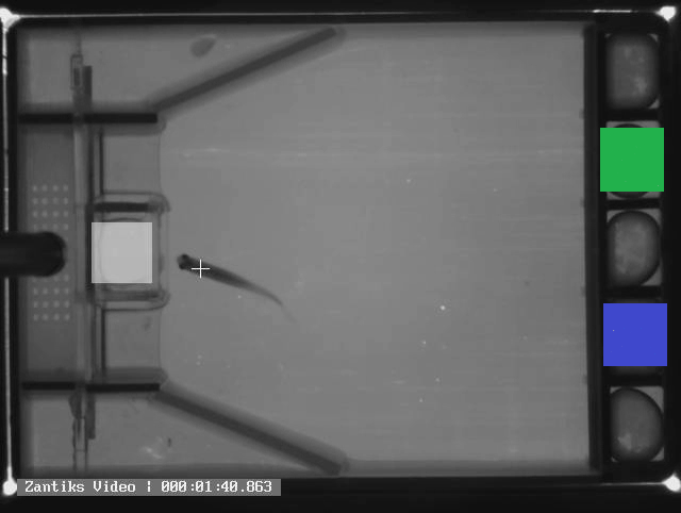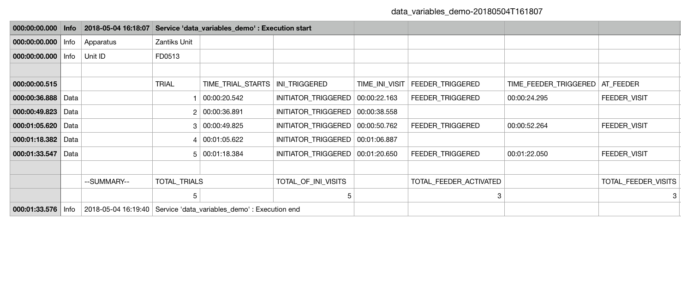Discrimination reversal learning paradigms are used to study behavioural flexibility. This protocol measures ability to both learn and unlearn a specific behaviour in zebrafish and has applications as an indicator for various neuropsychiatric disorders.
In these learning tasks, subjects are required to adjust their behavior when previously established reward-related contingencies are reversed. An animal is first trained to discriminate between two stimuli, one of which is rewarded and the other is not. Once this discrimination is successfully acquired, the rewarded stimulus is reversed and the animal must learn to suppress the established response while implementing a new response. Deficits in switching from the previously learned response are seen across various neuropsychiatric disorders, including substance abuse, obsessive compulsive disorder, Parkinson’s disease, and schizophrenia.

Experimental set up
The Zantiks AD and LT units can be used for discrimination and reversal learning in adult fish. The five aperture and food hopper inserts are used to create the experimental environment (see image A above). The food hopper insert is designed to form an area for the fish to enter and collect food reward, without the food escaping into the remainder of the tank, as well as an entry point for initiating trials. Two of the apertures in the five aperture insert can be used to create two distant entry points at the opposite end of the tank from food delivery. The two entry points act in a similar fashion to nose poke holes in a rodent operant task.
Colour stimuli is typically used for this experiment, which is presented from the integrated screen below the testing tank. However, various visual stimulus types can be presented, including shapes, stripes or images. Target zones are assigned to specific locations within the tank (e.g., the two stimulus light locations). Responses are detected when a fish enters these zones.
Experimental procedure
Typical reversal learning procedures occur in two testing phases. In the acquisition phase, subjects are trained to discriminate two visual stimuli (e.g., blue vs. green light), where responses to the CS+ (e.g., blue light) are reinforced and those to the CS- (e.g., green light) are not. Once the animal demonstrates successful discrimination learning by reaching the set learning criterion (e.g., 80% correct in a given number of choices or n consecutive correct choices), the reversal phase begins with the reward-related contingency reversed. Responses to the green light are now reinforced, and responses to the blue light are not reinforced.
Results / data output
The typical main measures of a subject’s ability to learn the discriminations in a reversal learning task are the number of trials to criterion (TTC) and the number of errors to criterion (ETC). Additional measures recorded for each trial can include response latency and the number of omissions. The Zantiks systems can automatically measure and process behavioural endpoints in an easy to read format.
- Trials to criterion (TTC): number of trials to reach the set learning criteria (CORRECT + INCORRECT) – the main measure of accuracy.
- Errors to criterion (ETC): INCORRECT only – correlated measure of accuracy not affected by increased omission rates.
- Perseverative errors – consecutive responses to the previously reinforced stimulus. Provides a measure of the ability to initially shift away from a previously relevant response.
- Regressive errors – responses to the non-rewarded stimulus after making a presently correct response. Allow a measurement of the ability to maintain a new response after the initial shift away from a previously learned response.
- Omissions: trials where no response is made – a broad measure of the animal’s motivation level.
- Response latencies – time elapsed between stimulus presentation and a response – a measure of motor function and/or speed of processing.
- The performance during both test stages are frequently analysed with independent samples t-tests, one-way ANOVAs or two-way repeated measures ANOVAs, depending on the number of factors.
Results data file
The image below illustrates some of the results that were processed during the service following a trial with a fake fish. This will save onto the unit in the Data file folder as a .csv file.
During this trial the initiator was activated 5 times, the feeder activated three times and the feeder zone subsequently visited three times and the shoal was activated twice.
Download the full data file as a .csv file here.

Protocol scripts downloads
There are five separate scripts for the Discrimination Reversal learning assay for adult zebrafish. The initial four scripts will shape the subject's behaviour to the needed response and the final script introduces the discriminatory stimuli. Simply reverse the colours in the script for the reversal learning step.
There is one asset you will need which creates the initiator, feeder and stimulus light areas.
- 2choice_pavlovian_conditioning.zs
- Only the feeding area light is presented along with a food reward given. No behavioural contingency is used for this step.
- 2choice_stimulus_light_training.zs
- The 2 white stimulus lights are presented simultaneously. Either light entered will result in food reward.
- 2choice_initiator_light_training.zs
- Only the initiator light is presented now and needs to be entered in order food reward to be given.
- 2choice_ini_stimulus_training.zs
- Initiator light needs to be entered in order for both white stimulus lights are to be presented. Food reward can be obtained by entering either of the stimulus locations.
- 2choice_colour_discrimination.zs
- Similar to step 4, but now entering the initiator light triggers two coloured stimulus lights. Food reward will be given when the 'correct' stimulus location is entered.
Assets
You will need to upload the asset into the Asset directory on your Zantiks Control Console and ensure the correct asset name is in the LOAD(ZONES,"name_of_asset") command in the script.
See the Calibrating your Zantiks unit page and Asset building in the AD unit page or Asset building in the LT unit page for details on how to create assets customised to your system.
References



